Emerging Roles of Thrombospondin Family Proteins in Pathogenesis and Risk Assessment of Atherosclerotic Vascular Disease
Keywords:
Thrombospondin, Pathogenesis, Atherosclerotic Vascular DiseaseAbstract
Background: Atherosclerotic vascular disease underpins a vast majority of cardiovascular morbidity and mortality,encompassing not only coronary artery disease but also cerebrovascular and peripheral arterial complications. Despite extensive knowledge of classical risk factors, there remains a critical need to understand the molecular mediators driving atherogenesis, plaque progression, and vascular complications. The thrombospondin (TSP) family of matricellular proteins—including TSP-1 through TSP-5—has recently emerged as a group of multifunctional regulators with distinct and overlapping roles in vascular biology. These glycoproteins mediate extracellular matrix remodeling, cellular adhesion,immune cell recruitment, angiogenesis, and the regulation of inflammatory and thrombotic responses, thereby influencing every stage of atherogenesis and vascular injury repair.
Downloads
References
Tucker RP, Adams JC. Molecular evolution of the Thrombospondin superfamily. Semin Cell Dev Biol. 2024;155:12-21.
Murphy-Ullrich JE. Thrombospondin-1 signaling through the Calreticulin/LDL receptor related protein 1 Axis: functions and possible roles in Glaucoma. Front Cell Dev Biol. 2022;10:898772.
Zhang K, Li M, Yin L, Fu G, Liu Z. Role of thrombospondin-1 and thrombospondin-2 in cardiovascular diseases. Int J Mol Med. 2020;45(5):1275-1293.
Downloads
Published
How to Cite
Issue
Section
License

This work is licensed under a Creative Commons Attribution-NonCommercial 4.0 International License.
Attribution — You must give appropriate credit, provide a link to the license, and indicate if changes were made. You may do so in any reasonable manner, but not in any way that suggests the licensor endorses you or your use.
NonCommercial — You may not use the material for commercial purposes.
No additional restrictions — You may not apply legal terms or technological measures that legally restrict others from doing anything the license permits.



